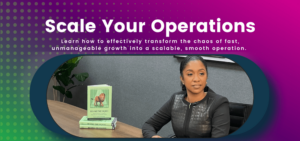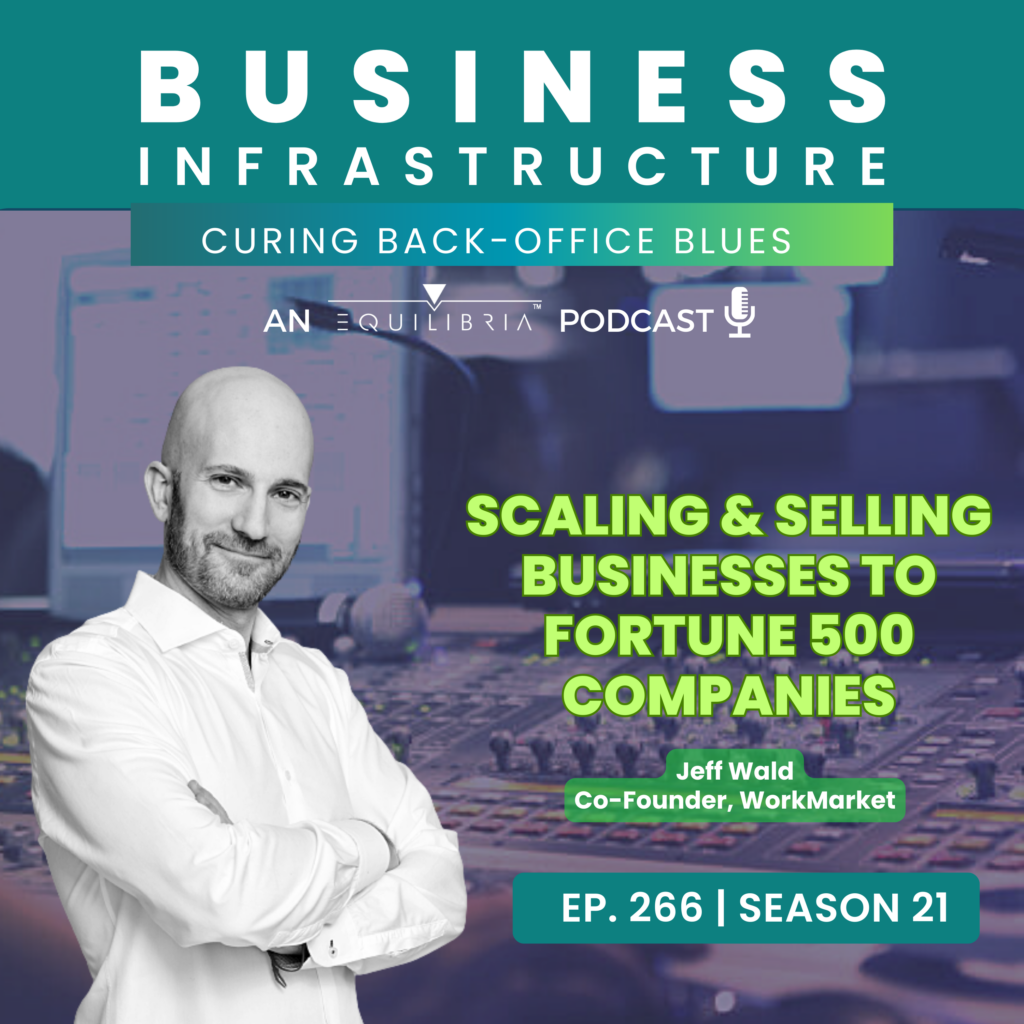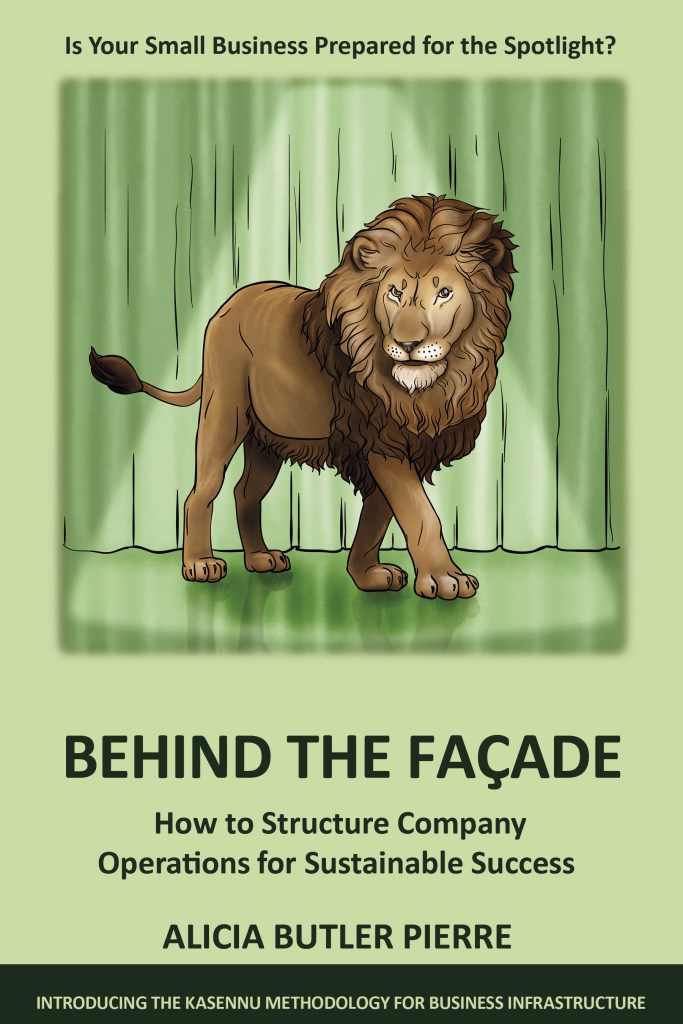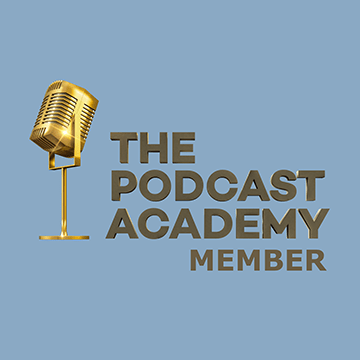Transcript
Hi! I’m so glad to see you! Thanks for coming back. Yes, it’s been a few weeks since we last spent time together, but I promise you this next episode is worth the wait! Let’s head on over to the podcasting vault. You know the routine – grab a seat and some headphones so we can get started.
This podcast is brought to you by Equilibria, Inc. We design business infrastructure that frees you from the chaos of fast growth, scales your operations, and increases the value of your small business.
This is Season 21 of the Business Infrastructure podcast. On this show we share operational tips, strategies, and tactics to help you cure any back-office blues you might be experiencing. I’m Alicia Butler Pierre and this season we’ve remastered some of our most popular episodes using our show’s new format.

Before we start the interview, I have a question for you. How many times have you heard a company advertise that they can help you grow or scale your business? Grow and scale are two words that are used so much by companies of every industry that it’s become cliche to say them. In my opinion, scaling a company requires business infrastructure and streamlined operations to increase bandwidth. And not every company can offer that, nor does every entrepreneur know how to do it, except for today’s guest. He knows how to scale. In fact, he’s about to give you a crash course on how to scale your business.
This is Episode 266 – Scaling and Selling Businesses to Fortune 500 Companies with Jeff Wald
I describe Jeff Wald as a modern-day Renaissance man. Not only has he successfully built, grown, scaled, and sold two businesses to ADP and Salesforce, but he also works as an angel investor and startup advisor. There’s so much to cover in this interview so let’s not waste any time as I first ask Jeff how he’s doing and how did he, a Harvard MBA grad, ended up doing a brief stint working at the NYPD or the New York Police Department.
I am great, Alicia. It is great to be here. I was an auxiliary officer. I did not have the honor of being a full-time officer in the NYPD, but just a volunteer, which was an amazing experience.

Post 911, and it was a way that I could get involved. I always reflected on the conversation I had with my dad as I was going off to school. He said to me, “Look, I’m going to pay for college, and I expect you to do the same for your children. But I want you to know something, Jeff. What I’m not going to ask you is what my father asked me, which is, ‘When do you plan on giving your two years to your country?’”
And that was something that every member of my family, male, unfortunately, had done. And my dad served in the Air Force as a dentist. And I thought, That’s great. It is not required of me. But I still feel like I should. And I didn’t.
But when 911 occurred, I reflected a lot on that conversation. And when I talked to friends of mine in the military about joining the military post 911, literally all of them were like, “No, that’s ridiculous. Your place is in the private sector. You keep the economy strong. Let us worry about fighting this fight.” And I listened to their advice and said, “Okay, I get it.” But I didn’t really love it. And then when I heard about this program in the NYPD where you could go through about 100 hours of training at the police academy, and you get a police uniform.
Put on that uniform, and you go and patrol a post within a precinct. And you are supposed to act as another set of eyes and ears for the police. You’re not supposed to interdict or fight crime directly, but obviously, in your walking a beat, you do come across things, and you get involved in situations. And it was a way I could do something, a way I could serve my community, my city, my country. And it was a wonderful experience I’m very glad I did.
Let’s go back in time a bit. Remember when I said that Jeff is a modern-day Renaissance man? Well, it turns out prior to him going to Harvard’s Business School, he went to work at the premier investment banking and asset management company, J.P. Morgan.
I was an M&A banker at JP Morgan for four years pre-business school and one post-business school. JP Morgan was kind enough to pay for business school for me. So, I paid for none of my education. My dad paid for my undergrad and my first grad degree at Cornell.
Part of Jeff’s contractual obligation for having his business school education paid for required working an additional year for JP Morgan once he successfully completed his studies. Once that term was up, he began exploring other opportunities.
I left and went to an Israeli tech-focused investment firm, and loved it. And that’s where I got the bug, if you will, on entrepreneurship and startups, because we were writing checks to startups, to these men and women who were taking that risk and saying, “There’s a better way to do this. And I’m willing to bet my time, my money, my career trajectory on being right. And if I’m wrong, I’m going to pick myself up, dust myself off and try again.
And there was something so incredibly empowering about it. And capitalism will reward you if you’re right to the tunes of millions or more dollars. And if you’re wrong, we live in a system where you can pick yourself up, dust yourself off and try again. And everything about it was so energizing and so it was post that experience that I started my first company.
And, as if prophetically, Jeff started his first company and, well…

This is the company that ultimately failed and basically bankrupted me. Even though I was already 32, I thought, No, we don’t need anybody’s money. I’m going to do this myself. I’m going to own more of it, and we’re going to break money. And, yeah, no, it didn’t work. It didn’t work at all. And we could spend hours talking about why it failed, but the important part is that it failed. And I will tell you when it did fail, it crushed me financially.
With moral support from friends and family, Jeff dusted himself off and got back into the entrepreneurial game, but as a side venture while he worked full-time at a hedge fund company. This time, he struck gold!
While I was there, they gave me enough latitude to restart that first concept, and I brought in some new co-founders, and we got it together, and it eventually got sold to Salesforce. And so, it ended up being a great journey from an experience standpoint and a monetary standpoint, but there were a lot of peaks and a lot, a lot of valleys before the final peak, which was its monetization. And then we started WorkMarket, which is by far my longest entrepreneurial journey and most successful.
Surely there are a lot of lessons packed into that condensed timeline Jeff just gave. I asked if we could start with lessons he learned from his business that failed before he started it again and was able to scale and sell it. Turns out many of those lessons came from his days with the NYPD with one of them being…
Ask for help. You are taught in the academy the most powerful weapon you have is the radio. And get on that radio and call in with your location, with the situation, and say, “Send help!” Being able to learn to ask for help from your friends, from your advisors, from your colleagues, from your investors, from your customers, from your partners, you have to be able to do it. Because if you’re trying to come up with all the solutions on your own, you’re just decreasing your probability of success.
In sharing about the importance of asking for help, Jeff thought that his experiences in starting, growing, and scaling WorkMarket would be better suited for a conversation on business infrastructure. Business infrastructure is a system for linking people, process, and tools and technologies that enable scale to happen in a repeatable, profitable and sustainable way. Pay close attention as Jeff explains the people element of business
infrastructure and their role in the different phases of a business.
It’s funny because every time I talk about startups, I always talk about people, process and technology. So, we are very aligned. And I usually talk about them in three phases. Okay. And phase one is that incubation phase, right? There’s nothing there. It’s you and a blank piece of paper and a pen and just to name the phases, that’s phase one. Phase two is when you get your first customer, Everything changes when you have your first customers because you can’t now say “Hey, let’s all spend a week and just think
about this.” You can do that in the incubation phase, but when you get to the revenue phase, there’s no doing that because your customers are counting on you. And then there’s the third phase which is the scale phase.

And that’s when there are a lot of customers, and you need process. And it’s not just, Oh wait, that customer has a problem, I’ll just jump on the phone with him or her and solve it. It’s, No, that has to be a formal process because there are so many problems.
In other words, as the demand for your business grows, so does the need for more people and, in all likeliness, the introduction of errors can also increase if processes are not in place to ensure consistency in your goods or services.
So, when I think about people, I think about the types of people that are optimized for phase one. And those are the people that are very free thinking, they are very unstructured in the way they think. And you want them to be unstructured because the work is unstructured, and the solution is unstructured. You don’t really know what you’re going to build. You have a broad idea, but you don’t know the bits and the bots and what’s going to really happen.
And so having people that can work in a very unstructured environment, that are self-starters, that are self-thinkers, that are people that go through walls. That initial team at WorkMarket, my gosh, I would hire any of them again in a heartbeat. These were the people who would sit there and be in the office for three days straight and just say, “No. We all said we’re going to get done by Friday, so there is no not getting it done by Friday, and we’ve got 72 hours. Let’s just work for 72 hours and we’ll get it
done.” That’s not a normal person.
But here’s the thing about those people. When you start to move into phase two, they start to struggle, because now it’s no longer, Hey, let’s just stay up and figure this out. Hey, let’s launch some stuff and see if it breaks. It’s, No, guys, we have customers, and we can’t be F’ing around anymore. People depend on us. And by phase three, they’re all going to be gone.
And to me, when I think about my startup journey and the difficulty of scaling, one of the biggest difficulties for me was recognizing that those people had to go, because very few people are that selfreflective to be like, “Yeah, man, this company’s moved beyond me. It’s time for me to go.”
The kind of person that is willing to stay up 72 hours straight is not the kind of person that sits down and says to a direct report, “Well, what are your goals? What do you hope to accomplish?” They basically say, “Here’s what needs to get done. Get it done or go.” They’re not nurturing. They’re bulldozers. And so, as a manager, as a leader, knowing that you must turn that team is challenging because those are the people that got you there. They got you to your customers, and now you’re saying to them, you’re not really developing into a manager and a leader. You’re a bulldozer. And we’re kind of done bulldozing. I need very fine artists now, and that sucks. It’s a terrible conversation to have to have.
Listening to Jeff talk about the types of people needed in the incubation, revenue, and scale phases of business reminds me of the three types of people discussed in the popular book, The E-Myth. In that book, Michael Gerber, the author, talks about the entrepreneurs who are the visionary, big-picture thinkers, the managers who are the people who dot all i’s and cross all t’s, and then the technicians who focus on doing the technical work.
In phase one, there is no process. Did someone remember to order? None of us have eaten in 24 hours. I’m going to go get some pizza. Everybody just chills out. That’s the process. In phase two, you have to start with the process. But if you overprocess, you’re going to mess up. You’re going to mess up your phase three because, in phase two, you’re just starting to get those customers in. And I always love saying to entrepreneurs, as smart as everybody is, you really don’t know a darn thing. You don’t really know when you have 1000 users, and you see how 1000 different people are interacting with your tech.

What kind of questions are they going to have? What types of customers are we attracting? What are their needs? What are they going to need for an upsell? What is our pricing plan going to be? What will the market bear? And blah, blah, blah, blah, blah. Once you start understanding those things, now put process around upsells and pricing structures. But if you try to do that in the beginning, you are going to put the wrong process in place and so customers start to come on you.
We need people that understand process but aren’t driven by it, that are there to look at what’s happening, much like your technologists looked at what was happening in the market and talking to beta users. Your manager layers, they come in, they’re going to look what’s happening and be thinking about what process to put in place, but not burden it yet until you get to phase three. Because in phase three, if you don’t have process, you’ll break.
And this is exactly why I always say that business infrastructure is not something that most startups should invest in. You should give your business at least three to five years to figure out what your customers want so that you can then position your business to replicate and ultimately scale around that.

100%. You need to know what you’re replicating. Yes, we are singing from the same hymn book here because you don’t know what you’re going to replicate until you have enough data points. Your ideas are just that. They’re ideas. They may not survive evidence let the evidence come in and see what happens. See what actually replicates and then you have a process.
This is excellent!
This is great!
It is great! And you know what? We’re just getting started. Jeff will explain the difference between growing a business and scaling a business as well as the other two elements of business infrastructure – processes and tools – that are required for both. That and even more great information is coming up after the break.
In the world of business, success isn’t just about great ideas or products. It’s about having a strong foundation—a solid business infrastructure. But why is it so important?
A robust business infrastructure is like the backbone of an organization. It provides the necessary support for all our operations.
Business infrastructure ensures effective communication and collaboration. It allows teams to seamlessly share information, work together efficiently, and make informed decisions.
It also enables efficient data management. With proper systems in place, businesses can securely store, analyze, and utilize their data to gain valuable insights and make strategic decisions.
Thirdly, a strong business infrastructure promotes innovation and growth. It provides the flexibility to scale up operations, adopt new technologies, and adapt to changing market demands. It’s no wonder why a solid business infrastructure is essential for success. It enhances communication, facilitates efficient data management, fosters innovation, and enables flexibility—all vital for businesses to thrive in today’s
competitive landscape. Invest in a strong business infrastructure, and watch your business reach new heights!

At Equilibria, we’re excited to offer a free webinar opportunity where we’ll do a deep dive into business infrastructure. Stop being a victim of unmanageable fast growth and start building your own company’s business infrastructure. Don’t wait! Experience the order and calm that thousands of other small businesses have. Sign up now at SmoothOperator.Club. That’s SmoothOperator.club.
We’re back and before the break, we hinted at the fact that angel investor and serial entrepreneur, Jeff Wald, would explain growing a business and scaling a business. Are they interchangeable? If not, then what makes them different? It’s always good to listen to those who’ve successfully done both. So…how does Jeff define it?
Well, anybody can grow, right? I think that scaling is a subset of growing. It is a type of growth. But everybody that is growing a business is not scaling a business. Anybody scaling their business, their business is growing. There could be organic growth, there could be inorganic growth. You can add a few customers. But scaling requires a process and it’s a process that’s usually not in place. So, in my mind, when you get to scale, you’re breaking whatever existing process there was and you need to reprocess and potentially retool and repeal because whatever you had, you’re growing so quickly that it breaks.
To illustrate his point, Jeff went on to share an example of when he sold his company, WorkMarket, a company specializing in management services for temporary workers to ADP, a large tech enterprise offering human resource management services.
The day WorkMarket got bought by ADP, we’d sent the email out at 7:59. I insisted we send the email 1 minute before the press release got launched to our team. We had about 200 employees, and we all then gathered, ADP had a team of 1,000 people there with all kinds of video equipment, and they were live streaming it to different ADP offices and to the WorkMarket offices. We had offices in Boston, in Toronto, and down in Florida, and then we opened up for Q & A, and everybody at WorkMarket knows they
can ask any question they want, anytime they want, except what anybody else makes. That’s between me and them, me and that person. Any other question you can know the answer to. And so, they were indoctrinated with this. So, they didn’t change. When the president of ADP is sitting to my left, one of them, when we moved to the QA, said, “Well, why should we stay now? I don’t want to work for ADP.”
I said, “So, first off, you’re wrong about ADP. But that being said, even if we were bought by Amazon, Facebook, Google, whoever you are, I get why somebody that’s at a startup would know the number one reason they’re there is for that lottery ticket they got in their pocket, that equity and that lottery ticket just got cashed. So why would I stay when I could just go get another lottery ticket? I know what you guys all are thinking. You’re thinking, Hey, you just got a big exit and you all just got paid and that’s awesome. And now it’s time to go get another lottery ticket. And you’re not wrong to think that. However, you would be wrong to leave now.
You are going to give up on this very rare opportunity to watch a big, incredibly well-run company that operates at a size and a scale at which few companies on the planet operate. ADP has 810,000 corporate customers. They process trillions of wows, there are not a lot of people who get to say trillions as they talk about their business. Trillions of dollars are processed by ADP for you to get a chance to watch as ADP brings in their teams to change our process, our tech infrastructure and a host of things as
we go from a few thousand clients to 100,000 clients, because ADP’s teams are now selling us, as we go from eight salespeople to 8000 salespeople.
If you deny yourself the opportunity to learn from that and then in a year, 18 months, two years, go into an interview and say, Hey, I built it. I watched one of the biggest companies on the planet fix it and really scale it, and now I’m ready to go build it again from square zero. If you can say that to somebody, I’d hire you in a heartbeat. I don’t care what phase I’m at. I don’t care what you do, anyone that can say that to me.”

And so, when I think about phase three people, I really want somebody in phase three that’s been in the trenches, that understands what startup life is, what an entrepreneurial journey is, but has been at a big company before. And the ideal would be somebody that has bought somebody that built a team, went to a big company for a few years and then wants to come back and do it again. Because that person understands that journey of putting process in place on your own. Screwing it up. Watching big companies put in process, them probably screwing it up a little bit. But then going back and saying, You know what, I know what big companies need and I know how to do it. I’m going to do it! That to me is the perfect phase three person, sometimes phase two.
Jeff makes an interesting point – it’s rare that you can find what I call the “chameleon employee” – that person who can successfully transition from phase one to two and on to three. Usually, it’s because of the experience required to succeed in each phase. Phase three requires functioning in a corporate culture which can be very different from startup culture.
Violent agreement. This is why those people that are great in phase one literally none of them were there for phase three of work. None.
That is, none with the exception of Jeff himself. As he told me during the original interview, he wasn’t going to fire himself. However, he also made an astute observation regarding self-reflection while transitioning through the business phases he defined.
Well, I would say that self-reflection is super difficult for anybody at any phase or part of the organization. No different for the founder. I would certainly encourage every founder and almost all professionals, quite frankly, to get a coach. And I viewed my coach, who I was told to get by my board and I kind of went in kicking and screaming. I remember actually the conversation where our lead board member, who’s one of the most well-known venture capitalists in the world and most successful, kind of pulled me aside.
He said, “Look, we’re going to put more money into this next round. All the investors have agreed, so the next round is covered. But one of the predicates is you have to get a coach.” I was like, “What do you mean I have to get a coach?” He said, “Well, you need a coach.” I said, “I don’t need a coach. You need a coach!”
A little arrogant, aren’t we?
Oh, yeah. He just literally looked at me. He’s like, “Do you see what I mean?” All right. And so, I got a coach. And I would say that this coach who was one of the best humans I’ve ever met, he may help me become a better leader, certainly. A better manager, definitely. And a better person. And I am so much better off for that experience. And he helped me understand and be honest with myself about where I did things reasonably well and where I needed help. And without somebody that can do that for you, it
is a very low probability you’re going to do it on your own.
As we wind down our conversation, I asked Jeff if he could share some of the key processes he and his team at WorkMarket formalized as they scaled. He started by focusing on the sales and product development processes and the journey of figuring out the magic formula that could be repeated for continued success.

It took us a long time to understand where the salesperson had variability. We did not have a process in place on the renewals and the upsells and how do we upsell the implementation and upsell different features?
And we had to go through a journey of understanding which features really created the tremendous stickiness and how to upsell those, but basically give them away, if necessary, because those features are so powerful, and once people start using those features, they never leave us. When I think about the real challenges we had on process, it was really around code and the process of building code, because you go from a journey of just trying to get everything out there as quickly as possible.
To a journey of well, everything that we send out must be sent out so that it can scale, so that it doesn’t have any bugs, so that the process of putting things in place doesn’t break anything else or surprise customers. The number of times, Alicia, that we would hear from customers things like, “I’m not your QA department.” Or, “Guys, you can’t change and move a button. My entire team is trained as to where to go on the site, and you move stuff and you don’t tell me.”
If you need to have a conversation understanding which customers use which features the most and if they’re changing, then maybe it’s not just a PDF, it’s a phone call to walk them through it. There are certain customers we’re going to fly down and walk them through the new stuff that’s coming. And when you do a three-sprint release cycle, meaning you’re releasing every six weeks, it’s a lot and you can slip sometimes and every now and again, even though we started this process in year three and four, in year five and six, before we got bought by ADP, post-ADP, all these processes were rock solid.
But although those processes were rock solid, Jeff admitted they still weren’t in the clear. Why? Because processes are not static. They require continuous improvement.
We get a call being like, “You just did a bunch of things to my site!” I’m like, “Didn’t we say we weren’t going to do that?” But saying you’re not going to do it and having a process in place where it can’t happen unless you’ve done it are two very, very different things. And so, it took us a while to put in place the fail safes to know that things were, for lack of a better term, idiot-proof. You couldn’t go and release because the head of Customer Success hadn’t signed off yet and unless she signed off, the release wouldn’t go. Like it just couldn’t go without her password.

Even with imbuing Quality Assurance and Quality Control into key processes, Jeff still stressed the importance of striking a balance between moving fast and breaking things and breaking things too much that your customers leave.
Because if you never mess up, then you’re not pushing the envelope enough. But if you mess up too much, they’re going to leave you. You want to get into that space where you’re messing up and pushing the envelope, but not enough to upset your customers.
Being that WorkMarket is a technology company, I asked Jeff, as we discuss the third and final element of business infrastructure, tools and technology, if he could also share some key resources he recommends.
So, the first thing I would say is I think most startup ecosystems or entrepreneurial ecosystems have different founder groups. In New York City, we have the Founders Roundtable, which is a few thousand people on an email list serve, and we ask each other questions all the time. I might have six or seven emails a day from that list serve. Some of them you just look at and delete and others you say, “Oh, actually, I know the right thing for that.” I think your investors are a great place because they have seen it
before.
And so, asking them what kind of tools are useful? There are companies like Stack List that come to mind that put together those tool lists about what are the best CRMs, what are the best customer support tools, what are the best this, the best that conversations with other people that are in the same types of boat that you are, that are going down the same rivers you’re going down, conversations with them are going to be the most informative. The types of techs we used were very relevant to the labor space, very relevant to service companies that used freelancers. And so, I was certainly on the phone a lot with companies that are in some ways competitors, but we would share notes at the end of the day. Yes, they’re competitors, but you can certainly still be friends with your competitors.
And of course, we could not end this interview without asking Jeff to share perhaps his number one resource for you – his book.
When I was running WorkMarket, there were a lot of opportunities I had to go to conferences and obviously I read everything I could about the freelance market, and I got very frustrated Alicia because there were so many people talking about the freelance market that were talking outside of bodies of evidence. They were making predictions about where the freelance world would go and they weren’t thinking about the history of work, about the data that actually is very available in the world of work. They weren’t thinking about how companies actually engage workers.
And I started getting very frustrated because I am a very evidence and data driven person. So, I started writing articles and those articles started to turn into a book just on the freelance market. And then I very quickly morphed it into the entire world of work. So, what can we learn from the history of work, from the data patterns in the world of work, and from how companies actually engage workers in order to make a series of predictions about the future of work? What does it mean in the near term in regard
to globalization, in regard to total talent management and the on-demand economy? What does it mean in the long term in regard to robots and AI? And what can we learn about how companies and workers have come together to renegotiate the social contract in other tremendous step functions of technological change?
Because this is not the first time we’ve seen any of these changes. And so, I’m not saying it’s going to happen exactly the way it’s happened in the past, but I would say we’re foolish to not study the past, study the data and study how companies actually engage workers in making predictions about the future of work. And so that’s what I did with this book The End of Jobs: Rise of On Demand Workers and Agile Corporations.
Jeff’s book claimed the number one spot in all of Amazon’s HR book categories when it was released. Looking at the subtitle, I wondered if he intended the word, “agile,” to imply being flexible and adapting more quickly to changes in the economic landscape. So I probed a little more – I wanted to be clear on what he meant by “agile.”
There are a lot of trends at play here and I don’t have enough data to answer that question yet. There are a number of trends that COVID certainly increased and one of the most powerful is concentration. We have a concentration issue in the US economy where fewer and fewer companies represent more and more of the economic pie. And that has a lot of implications. When I talk about agile corporations in the book, I’m talking specifically around their labor structures because labor is the largest cost most
companies face, and it is predominantly a fixed cost. And the gig market, the on-demand market, is not new. It’s been a part of the labor landscape for generations, and it really hasn’t grown that much. There’s a general sense that, Oh, the on-demand labor economy is growing.
When I think about why companies are, to use your term “agile” versus the way I used it in the book, which was very myopic on just labor markets, but more agile on decision making, I think about companies that are very adept at understanding the data and what’s going on inside their company, outside their company with their customers, and very clear about who can make what decisions.
And just to make sure we understand what he means by being agile and interpreting data, Jeff reminisced as he explained WorkMarket.
In the early days of WorkMarket, everybody in the company was in one big room. We didn’t have offices and I sat right in the middle and all the people that built the product, product engineering, QA and everybody else was on my left. And all the people that moved the product sales and marketing and customer support implementation were all on my right. And sitting at me at the big desk in the middle was the entirety of our operations layer two other people. And the thing was that at any given moment
all the data was flowing into that desk, into that center desk. I knew everything that was happening in that company because we were all in one room.
There were 40 of us, but we were one room. And the decision making was also super clear. I made the decisions and if you had new information, I would change my decision. But if I didn’t have any new information and you didn’t like the decision, quit onboard or overboard or present me with new data.. And to me that made us very agile because I made the decisions, and I had all the data I needed to make the decisions or new data would be produced. When I think about a company like ADP, how do you get
that amount of data from 810,000 corporate customers that are on a bunch of different systems? It’s really, really difficult.
And how do you make decisions in an organization with 55,000 employees not to pick on ADP, because I love, love, love ADP, and everyone should use ADP and all of its products. But how do you do it in an organization of that size? I don’t view Amazon and Apple and Facebook and Google as these big giants. I view them as incredibly agile corporations because they were built from the ground up with data flow and decision-making in mind. ADP was built 70 years ago. Now they’re evolving into a tech company. In
another few years, I think they will rival all those companies and what they can do and things like that. But it just highlights to me, because I got to spend time at ADP is the only reason I know the inner workings there, that the data and the decision flows at a big company are really, really hard. I think ADP does it better than most, but they’re really hard. And that, to me, in the way that you correctly frame agile because I incorrectly framed it in the cover of my book. That, to me, is something that enables that agility.
And on that note, Jeff must leave us. Make sure you pick up a copy of his book. It’s called, The End of Jobs: The Rise of On-Demand Workers and Agile Corporations. Get a link to that and the other resources he mentioned at BusinessInfrastructure.TV. Again, that’s BusinessInfrastructure.TV.
Thank you for listening! If you enjoyed this episode, then please subscribe and leave a five-star rating and review.

Once again, it’s time to close the podcasting vault. I hope you’ll come back to hear the next remastered episode. You’ll hear from someone who advanced from being a salesperson all the way to the CEO of a tech company in Silicon Valley, scaling operations along the way.
Until then, remember to stay focused and be encouraged. This entrepreneurial journey is a marathon and not a sprint.
This podcast was written, produced, and narrated by me, Alicia Butler Pierre. Audio editing by Olanrewaju Adeyemo. The original score and sound design by Sabor! Music Enterprises.
This is the Business Infrastructure – Curing Back-Office Blues podcast.




















